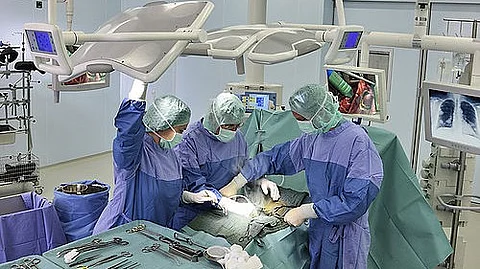Doctors Provide Pioneering Stem Cell Surgery to Drug-Resistant Epilepsy Patient
Doctors at the University of Chicago Medicine have performed the world's first bilateral stem cell transplant on a patient with drug-resistant bilateral mesial temporal lobe epilepsy (MTLE).
“It's a step into a new era," said Peter Warnke, MD, Director of Stereotactic and Functional Neurosurgery at UChicago Medicine.[1] "This is the first treatment to actually attempt to correct disease biology. All other current treatments — whether resecting, using laser ablation or electrical stimulation — are just removing or silencing tissue and not addressing the biology of the disease.”
The experimental operation is part of the first in-human clinical trial investigating the safety and efficacy of lab-grown interneuron cells to treat patients with a type of epilepsy that causes seizures in deep parts of the temporal lobes on both sides of the brain.
UChicago Medicine is participating in the 15-year, multicenter study involving 10 patients. The operation, which involved a 22-year-old patient with intractable epilepsy who experienced frequent seizures, took place in February at the Center for Care and Discovery.
Approximately three million people have epilepsy in the US, and up to 35 percent of those individuals experience ongoing seizures despite taking medications for the illness. During a seizure, the brain's electrical signals operate too synchronously and out of control.
For patients with bilateral MTLE, this burst of uncontrolled electrical activity can cause staring episodes, confusion, memory lapses or uncontrolled movements. The patient who received stem cells at UChicago Medicine had previously broken his spine twice due to severe muscle contractions during seizures.
Repeated seizures can also cause a loss of interneurons, the cells in the brain that help communicate with other cells, process information and control movements.
These cells secrete gamma-aminobutyric acid (GABA), a neurotransmitter that stops hyperactive brain cells from firing and causing seizures.
This study aims to essentially replenish those inhibitory cells to rebalance the electrical activity in the brain and diminish or eliminate the seizures.
A novel, less-invasive surgery
Traditionally, most patients with this type of medication-resistant epilepsy have two treatment options: Doctors can surgically remove or ablate the brain tissue causing the seizures, or they can implant electrodes that send small electrical signals to specific parts of the brain to stop or reduce the abnormal brain activity causing seizures.
"While removing or ablating epileptogenic tissue is very effective and can render the patient seizure-free, it can also have side effects, in particular, short-term memory and learning can be impaired post-surgery."
Peter Warnke, MD, Director of Stereotactic and Functional Neurosurgery at UChicago Medicine
The new, less invasive procedure involves transplanting NRTX-1001 stem cells into the left and right hippocampi.[2]
During the operation, Warnke first used a robotic stereotactic system that relies on CT and MRI scans to precisely target the area of the patient's brain causing seizures. He directed a narrow tube through the patient's skull to 10 specific areas in each hippocampus and injected the tissue with stem cells. Then, the UChicago Medicine team conducted further imaging to ensure the cell deposits were perfectly placed.
“Years of experimental studies have shown that transplanted interneurons integrate into the brain, secrete GABA and stay alive long-term,” Warnke said.
The patient, who has remained seizure-free since the Feb. 25 operation, will be followed meticulously. Because the stem cells are cultured in a lab and do not come directly from the patient, he will take immunosuppressive medications for roughly one year while the cells amalgamate into the brain.
UChicago Medicine is also recruiting patients for a study examining a similar treatment for drug-resistant unliteral MTLE. Patients at participating academic medical centers who received stem cell transplants in that trial have experienced seizure reductions lasting more than 12 months.
“This is a first step in addressing a biological treatment of intractable epilepsy where modulation of neuronal function is the objective instead of tissue destruction or electrical silencing," said Warnke. "In this regard, it's a neurosurgical dream come true. And the first results are promising.”
References
1. https://www.uchicagomedicine.org/find-a-physician/physician/peter-warnke
2. https://www.neuronatherapeutics.com/pipeline/#NRTX-1001
(Newswise/SS)


